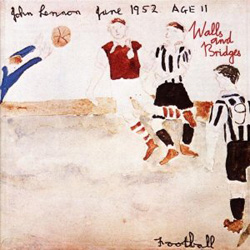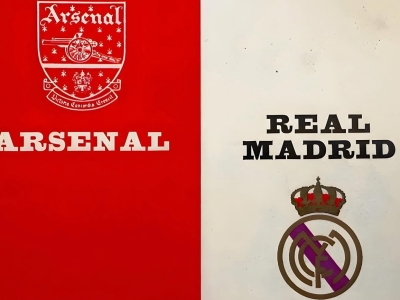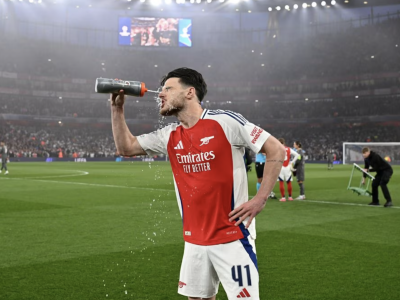Newcastle United visits to Arsenal have brought many firsts. The Gunners’ very first fixture in the Football League, then under the name of Woolwich Arsenal came against the Geordies on September 2nd 1893 at the Manor Ground in Plumstead. As Arsenal were the first team south of Birmingham to participate in the Football League, this game also has the honour of being the very first League fixture to be played in London or the South of England. Sadly, no video footage of the game exists, though Andy Kelly’s Arsenal history blog carries a report of the match here. Newcastle United were also newly elected that season and hence, the fixture also has significance as their first League fixture. The match ended in a 2-2 draw with Arsenal’s goals scored by Walter Shaw and Arthur Elliott.
Of Newcastle’s early visits to Arsenal, in April 1897 the Gunners enjoyed a 5-1 victory over the Magpies. Newcastle won their first title in 1904/05, that season the Geordies came away from Woolwich with a 2-0 victory on New Years’ Eve in front of 30,000 fans. Newcastle United returned to Plumstead on Christmas Day the following season and were involved in a yuletide goal-fest with Arsenal winning 4-3, which turned out to be Arsenal’s first top flight win over the Geordies. Arsenal of course left Plumstead for Highbury at the start of the 1913/14 season, the club however were languishing in the second tier at the time and had to wait until the start of the 1919/20 for top flight football to come to Highbury.
Arsenal’s first top flight game at Highbury came on 30th August 1919, the first time in which football had been played since before the Great War and a crowd of 40,000 turned out for the game. Arsenal’s visitors that day had again been Newcastle United. The Geordies however inflicted a 0-1 defeat on the Gunners with Newcastle’s James Henderson becoming the first player to score a top flight goal at Highbury. Newcastle’s last league title came in 1927 and commemorated here in a silent Pathe News piece. Newcastle famously beat Arsenal in the 1932 FA Cup Final (a.k.a. the ‘over line final due to the Magpies’ dubious equaliser), their path to Wembley was secured with a 2-1 win with over Chelsea at Huddersfield. On defeating Arsenal Pathe News captured their Post-Cup Final victory parade, where practically the whole town turned out in jubilation.
Newcastle United however dropped out of the top flight two years after their FA Cup victory over the Gunners and were to remain in the second tier until 1948. Their last league fixture at Highbury before the war came in 1930, where Arsenal won 3-0 with goals from Ralph Birkett, Ray Bowden and a Newcastle own goal. This here is a British Pathe News footage on Newcastle United in training while in the second tier in 1938. Newcastle returned as second tier runners up, however exited the FA Cup losing to the era’s Premier Cup side Charlton Athletic 2-1 at the Valley (Charlton reached the previous two FA Cup Finals - runners up 1946 and winners in 1947 after beating Newcastle 4-0 in the Semis).
In November 1948, Newcastle visited reigning Champions Arsenal at Highbury, taking all three points by inflicting a 0-1 defeat on the Gunners. Arsenal however took revenge the following season with a 4-2 win at Highbury, with a hat-trick from Peter Goring and a goal from Reg Lewis around a month before he became the Gunners’ cup hero scoring twice in the 1949/50 FA Cup Final. Newcastle won the FA Cup the following season and in 1952 came back as the reigning Cup holders to face Arsenal at Wembley. The man who made the difference at Wembley that day came from a rather unlikely background for an early 1950s FA Cup hero.
George Robledo, along with his brother Ted (or Jorge and Eduardo as were their birth names) who also turned out for the Magpies, were born in Iquique in Chile to a Chilean father called Aristides Robledo and an English mother called Elsie Oliver who emigrated to South America as an eighteen year old to work as a governess for an English mine manager, whom Aristides worked for as the company’s accountant. The Robledo brothers had moved back to Yorkshire in 1932 at a young age due to political instability in their home country, as well as the break-up of their mother and father’s marriage.
Both signed for Newcastle from Barnsley in 1949, where George in 164 games for Newcastle netted a stunning 91 goals, even earning a call up to Chile’s 1950 World Cup squad in Brazil, where he faced his adopted country during the group phase in the Maracana Stadium where England triumphed 2-0. In the 1951 final Robledo laid on Jackie Milburn’s first goal in a 2-0 win for the Magpies and during the Newcastle’s 1952 FA Cup run scored in all but one round on route to Wembley. The Magpies’ Cup run in 1952 started against Aston Villa with the Geordies coming back from two goals down to win 4-2 with George Robledo on the score sheet along with Billy Foulkes and two for Bobby Mitchell.
In the fourth round they were drawn away to reigning League Champions Tottenham Hotspur, where the Geordies destroyed Spurs 3-0 at White Hart Lane with Robledo scoring two. The Geordies went on to face Swansea away at the Vetch Field in the next round, winning 1-0, with a goal from Bobby Mitchell before going to Fratton Park in the Quarter Final to meet Portsmouth, with a 4-2 triumph for the Magpies secured by a goal from George Robledo and a hat-trick for Jackie Milburn. In the Semi Final at Hillsborough, Newcastle played out a 0-0 draw with Blackburn however three days later triumphing 2-1 at Elland Road in Leeds with goals from George Robledo and Bobby Mitchell, while in the final against Arsenal George Robledo headed the winner against a ten-man Arsenal side six minutes from time to become the first side of the twentieth century to retain the Cup and returning to Tyneside to a hero’s welcome.
The 1952 FA Cup Final also left its mark on an eleven year old John Lennon, whose drawing of the game ended up on the cover of his ‘Walls and Bridges’ album released in 1974 (seen above). Arsenal were to get their revenge in the League the following October with a 3-0 victory with goals from Doug Lishman and two for Don Roper on their way to the League title in 1952/53. At the end of that season however, the Robledo brothers left Tyneside to return to Chile to play for Santiago-based side Colo Colo, winning two Chilean League title and appearing for Chile in the 1955 South American Cup Final on home soil, losing 0-1 to Argentina. After they both retired in 1957, George went on to join the organising committee of the 1962 World Cup held in the nation of his birth. Ted however was sadly believed to have died in mysterious circumstances aged just forty two.
After retiring from Football, Ted began working for an international drilling company and took up employment in the Persian Gulf. In December 1970 was reported missing from a ship called the Al Sahn, which had been sailing out of Dubai. It was believed that Ted became embroiled in an argument with the ship’s German captain Hans Besseinich, who invited him to spend a few days on the cruise vessel, and was thrown overboard from the Al Sahn. Ted’s body was never found, however the captain was subsequently charged with ‘wilfully and unlawfully causing the death of Robledo in a brutal and savage manner’. The captain of the Al Sahn initially denied Robledo was ever on board the vessel, though other passengers provided evidence to the contrary. Besseinich however was found not guilty after claiming that Ted had taken his own life by jumping overboard.
Meanwhile, back on Tyneside there would be one more Cup win in 1955, their passage to Wembley secured by beating third tier York City in the Semi Finals. After a 1-1 draw on a quagmire of a pitch at Hillsborough, Newcastle went through with a 2-0 win at Sunderland’s Roker Park. Another hero’s welcome awaited them after victory in the final. The following season in their defence of their trophy, Newcastle played out an incredible fourth road tie at Craven Cottage against a Fulham side captained by the recently departed Jimmy Hill, in which Newcastle raced into a three goal lead.
The Cottagers managed to pull the score back to three each before Hill put Fulham 4-3 up (and from the Pathe News footage is seems that back in 1955 Jimmy was even a pioneer of football’s ecstatic celebrations, running off and high fiving his team mates in jubilation). Newcastle however put away the equaliser by simply bundling the goalkeeper over the line (which was legal then), before putting away another to secure a 5-4 victory over Fulham at the Cottage. Newcastle’s period as England’s premier cup side however came to an end with a 0-2 home defeat to Sunderland in the Quarter Finals.
Newcastle United’s Cup winning period of the early fifties however gave the club great exposure being as it was the only game shown live on television in full. Unsurprisingly therefore, it was Newcastle United who wished to exploit television’s potential for commercial revenue to the full. In 1955, Magpies’ chairman Stanley Seymour proposed a breakaway made for TV, ten-club Wednesday evening Anglo-Scottish Floodlit League for the newly formed ITV, who were willing to offer clubs such as Arsenal, along with Sunderland, Spurs, Hearts, Hibernian, Celtic and Rangers £50,000 for the privilege. Although the idea was a prototype of the Premiership, it was conceived to run alongside the Football League and the Scottish League rather than as a replacement, however it failed to receive the sanction of both Leagues and the clubs involved were threatened with expulsion if the plan went ahead. Arsenal, along with Celtic and Rangers withdrew, however the tournament went ahead unofficially as a friendly tournament for three years between 1955 and 1958.
At the end of February 1960, the cameras caught a Newcastle visit to Highbury in which Arsenal won 1-0 with a goal from John Barnwell. By the time of the Magpies’ next visit to Highbury, there had been the emergence of a ground breaking deal between the Football League and ITV to show regular Live football, which commenced on 10th September 1960 with a rerun of the Coronation Cup Final of 1953 between Blackpool and Bolton Wanderers. The game however failed to recapture the action of seven years ago and ended in a 1-0 win for Bolton, the attendance for which had been just 17,166 (around 12,000 less than the corresponding figure for the previous season) as a result of the kick off time being moved to 6.50PM.
The TV viewing figures for the game had turned out to be nothing particularly special and among those who watched many complained that ITV had placed their camera high up behind the goal rather than on the half way line. The poor reception this game generated had helped to shape, or in many cases even confirm, many sceptical attitudes to the possible negative effect of television to the Football industry. It’s also easy to forget that by the early 1960s, the negative effect which the popularisation of television had on many sectors of the pre-war and early post-war entertainment industries, such as many cinemas turning into bingo halls, or the closure of theatres and music halls (as seen with Camden’s Bedford Theatre in the opening scenes of the 1967 documentary film ‘The London Nobody Knows’ @01.35).
The effect was also felt on Stadiums which catered to other popular pre-war sports such as Clapton, Hackney, West Ham and Haringey Stadiums where Speedway and Greyhound meetings were carried out, but within a few years would lay as derelict as the Bedford Theatre. Therefore many within the game had every right to justifiably fear the effect of television. One week after Blackpool v Bolton, ITV were scheduled to turned up at Highbury to capture Arsenal’s League fixture with Newcastle United, however the Arsenal board of directors reflected on the negative reception of the match the previous week and turned the cameras away, meaning that the game kicked off at the usual time of 3PM, with Arsenal winning 5-0 with goals from Danny Clapton, Geoff Strong and a hat-trick for David Herd.
Where Arsenal led Spurs followed, as ITV were lined up to cover Tottenham v Aston Villa the week after – the result of which had been 6-2 to Spurs. Had either of these more exciting games been shown, the history of live football could have turned drastically different, with regular live coverage of English football starting over two decades earlier than it actually did. However, four years on from the failure of ITV to establish live League football on British TV came the introduction of Match of the Day. Newcastle’s first appearance on the show in February 1965 however came in the second tier, where the Magpies suffered a 1-2 defeat to Leyton Orient. On Newcastle’s return to top flight football after a period in the second tier, their visit to Highbury in October 1966 would be also covered on the show.
The previous spring Arsenal won the FA Youth Cup and from the Gunners’ batch of youngsters from the late 60s and early 70s – i.e. Radford, George, Rice, Kelly, Kennedy etc. – few would recall the names of Mickey Boot and John Woodward – however both teenagers would make their debut in this fixture. Within three minutes of making his first start in the first team, right half Mickey Boot would score with a shot from twenty yards. The Gunners’ grabbed a second with an own goal from Frank Clark, meanwhile Newcastle goalkeeper Gordon Marshall would be stretchered off with an injury, as Arsenal secured all three points with a 2-0 win.
The next three Newcastle visits to Highbury would end in a 0-0 draw, with the fixture in November 1968 billed by Movietone News as Arsenal’s ‘Golden Jubilee’ match, celebrating fifty consecutive years of the Gunners in the top tier. By the time Newcastle came to Highbury in mid-April 1971, Arsenal would finally be in the running for the League title and a Charlie George goal managed to put the Gunners top of the table with a 1-0 win, while Leeds Utd lost at home to West Brom. The following August however, Tyneside found a new hero in signing Malcolm MacDonald from Luton Town and on his debut would grab a spectacular hat-trick at St. James’s Park in a 3-2 win over Liverpool.
In October of 1971, Arsenal would play Newcastle United twice within three days and score four goals on both occasions. Arsenal would meet the Magpies in the third round of the League Cup on October 6th and secure a 4-0 win with goals for George Graham, Ray Kennedy and two for John Radford. Three days later in the League, Arsenal secured a 4-2 win with goals from George Armstrong, George Graham, Ray Kennedy and Eddie Kelly, meanwhile both Newcastle goals would come from future Gunner Malcolm MacDonald. In January 1973 at Highbury, the two sides played out a 2-2 draw with goals from Alan Ball and Ray Kennedy for Arsenal while Jimmy Smith and Malcolm MacDonald were on target for Newcastle.








